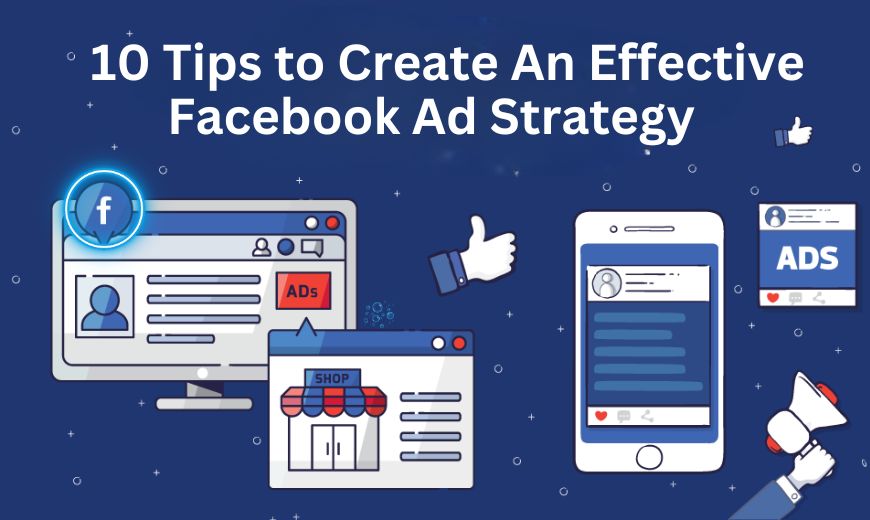
In today’s digital age, Facebook advertising has become a crucial component of any marketing strategy. With over 2.8 billion monthly active users, Facebook offers unparalleled reach and targeting capabilities for businesses of all sizes. However, without a well thought out strategy, your Facebook ads may not yield the desired results. Here are five tips to help you create an effective Facebook ad strategy that drives engagement, conversions, and ultimately, business growth.
Step 1: Identify Your Ideal Audience
At the forefront of successful Facebook ad strategies lies pinpointing your ideal audience. Effective ads hinge on reaching the precise demographic. Achieving this requires a clear understanding of who you intend to engage with your ads.
When identifying your target audience, consider those most inclined to require your products or utilize your services.
Delve into characteristics such as:
- Age
- Gender
- Location
- Occupation
- Buying tendencies
- Interests
- And more
Gaining insights into these aspects furnishes a comprehensive profile of your target audience, enabling you to tailor your ads precisely to those you aim to connect with.
Step 2: Implement the Facebook Pixel
An indispensable element of your Facebook ad blueprint is the Facebook pixel. This coding snippet is seamlessly integrated into your website, enabling the tracking of visitor data. It serves as a valuable tool in comprehending the interests of those engaging with your content.
Installation of the pixel occurs on the backend of your website. Once in place, it initiates data tracking from visitors to the web pages where it’s embedded.
This feature holds dual significance.
Firstly, it aids in elucidating the demographics engaging with your business. If you find yourself uncertain about your target audience, the Facebook pixel provides valuable insights into visitor demographics.
Secondly, it facilitates the evaluation of your Facebook ad campaigns‘ efficacy. By tracing the pages visited subsequent to ad clicks, it offers a comprehensive understanding of audience behavior and their journey toward conversion.
Adopting the Facebook pixel emerges as a cornerstone in refining audience comprehension and enhancing conversion rates, making it an essential strategy in your Facebook advertising arsenal.
Step 3: Establish a Sales Funnel
In the realm of Facebook advertising, campaigns often encompass diverse objectives, such as driving website traffic, soliciting email sign-ups, or facilitating product purchases. Each of these objectives targets individuals at varying stages within the sales funnel.
Thus, it is imperative to configure your sales funnel before launching your ads. Your sales funnel delineates the journey prospects undertake from initial awareness to eventual conversion.
So, why is crafting a sales funnel considered one of the paramount Facebook ad strategies?
Primarily, it enables the delivery of tailored ads to your audience at opportune moments. Presenting a product purchase ad to someone newly discovering your business might not align with their stage in the journey. Conversely, an invitation to join your email list might resonate more effectively.
By establishing a sales funnel, you gain insights into which ads to deploy as prospects progress through the funnel. Embracing this methodology empowers you to optimize ad performance and enhance overall outcomes.
Step 4: Experiment with Both Budget Types
For seasoned practitioners of Facebook ads, the distinction between daily and lifetime budgets is well-known. Your daily budget signifies the amount allocated for each day’s advertisement, while the lifetime budget reflects the total expenditure for the entire campaign. One of the most effective Facebook ad strategies involves exploring both budget settings.
You may discover that certain ads perform optimally with a lifetime budget, while others thrive under a daily budget framework. For instance, if you’re running a week-long sale, opting for a daily budget ensures consistent ad visibility throughout the duration of the promotion.
Conversely, when offering a first-come-first-serve free trial or product, a lifetime budget might prove more advantageous. This approach enables Facebook to allocate more resources during periods of heightened engagement, thereby facilitating goal achievement.
By trialing both budget options, you gain valuable insights into what resonates best with your ad campaigns, thus optimizing results for your business.
Step 5: Experiment with Diverse Ad Formats
In devising your Facebook ad strategy, resist the urge to confine yourself to a single ad format. A key advantage of Facebook advertising lies in its versatility, allowing you to craft ads in various formats, including:
- Photo
- Video
- Carousel
- Dynamic product ads
- Slideshow ads
- And more
Each of these formats presents distinct advantages for your business and influences prospects’ engagement with your ads. Exploring different ad formats enables you to gauge their impact on ad performance, thus enhancing your advertising strategy’s effectiveness.
Step 6: Craft Compelling Ads
Among the paramount Facebook ad principles lies the creation of compelling, high-quality ads. While this guideline may seem evident, it’s crucial to delineate what constitutes a top-tier advertisement.
To maximize the efficacy of your ad campaigns, prioritize the following elements:
- High-Quality Visuals: The visual component serves as the initial attention-grabber, compelling audiences to pause their scrolling and engage with your ad. Ensure your visuals are crisp, clear, and visually appealing to provide viewers with an unobstructed view of your promotion.
- Informative Ad Copy: Equally vital is the content of your ad. Furnish your audience with valuable information that resonates with their needs and desires, compelling them to take action.
- Appropriate Calls to Action (CTAs): Guide your audience toward the desired action by incorporating clear and relevant calls to action. A well-crafted CTA informs viewers of the next steps they can take to engage with your offering.
By integrating these essential elements into your ads, you’ll cultivate superior results for your business, fostering increased engagement and conversions.
Step 7: Implement Customized Landing Pages
One of the most effective strategies to leverage within Facebook advertising is the utilization of custom landing pages. These tailored landing pages serve to maintain the focus of prospects, thereby increasing the likelihood of desired actions being completed.
For instance, suppose your objective is to have users click on your Facebook ad to join your email list. If you direct them to your homepage instead, they may struggle to locate the email sign-up option, potentially resulting in missed conversion opportunities.
To streamline the conversion process for leads, consider employing a custom landing page. These pages are specifically designed to align with your ad content, offering concise and relevant information that guides users toward a singular action.
The implementation of a custom landing page is instrumental in optimizing conversion rates, ensuring that more prospects successfully complete your desired actions.
Step 8: Tailor Ads to Specific Audiences
Diverse audiences exhibit varying interests in your business. A pivotal aspect of your Facebook ad strategy is crafting personalized ads tailored to different audience segments. Tailoring ads to specific demographics allows you to resonate more deeply with each group.
Consider two distinct audience groups with contrasting characteristics:
Group A: Women aged 25-34, employed in middle-class positions, single, and inclined towards purchasing affordable yet functional products.
Group B: Women aged 45-54, employed in middle-class roles, married, and inclined towards investing in higher-quality goods.
Consider this scenario: If you were advertising your affordable desks, would the same ad appeal to both groups?
In this instance, it’s improbable, as individuals in Group B typically prioritize investing in higher-quality items.
Personalization allows you to tailor ads to suit the preferences of each group. For example, you could design an ad highlighting your affordable desks for Group A, while simultaneously running ads showcasing your higher-end desks for Group B.
Personalization can be achieved through various methods, including:
- Demographics: Targeting ads based on age, gender, location, and other demographic factors.
- Locations: Delivering ads to specific geographic areas, such as cities, states, or countries.
- Interest and hobbies: Targeting ads to people who have shown interest in specific topics, activities, or hobbies.
- Online behaviors: Targeting ads to people who have engaged with similar content, visited relevant websites, or demonstrated specific online behaviors.
- Shopping behaviors: Targeting ads to people who have purchased similar products, browsed related categories, or demonstrated shopping patterns.
By personalizing ads for different target groups, businesses can create more effective campaigns that drive increased revenue and conversions. This approach allows businesses to speak directly to their audience, increasing the likelihood of resonating with each group and ultimately driving business growth.
Step 9: Utilize Custom Audiences
Another highly effective Facebook ad strategy worth exploring is the utilization of Custom Audiences. Custom Audiences comprise individuals familiar with your brand, whether through website visits, engagement with your content, or similar interactions.
To create a custom audience, Facebook leverages the customer data you provide, comparing it with its user base to identify matches between your customers and individual platform users.
Facebook offers four distinct types of Custom Audiences:
- Website Custom Audiences
- Customer List Custom Audiences
- Engagement Custom Audiences
- App Activity Custom Audiences
Each type of audience corresponds to the specific channels through which users engage with your brand. For instance, if website visits serve as the primary mode of brand discovery, Website Custom Audiences enable you to target ads towards these prospects effectively.
Track Ad Campaign Performance
Vital to maximizing the effectiveness of your ad campaigns is diligent monitoring of their performance. This underscores the importance of ad monitoring as a fundamental Facebook ad strategy. Failing to observe ad performance can result in missed opportunities for optimization and revenue generation.
To effectively monitor your ads, it’s imperative to define the metrics you wish to track. Whether your focus lies in analyzing clicks, conversions, or other key performance indicators, clarity regarding your objectives is essential. With established metrics in place, you can systematically monitor ad performance to ascertain whether your campaigns align with your predefined goals.
Step 10: Conduct Ad Campaign Testing
Completing our lineup of top Facebook ad strategies is the necessity to test your ad campaigns using Facebook Ads Manager. When vigilant monitoring via Facebook Ads Manager indicates underperformance, testing offers a chance to identify areas for improvement.
Conducting tests on your ads allows for the exploration of alternate versions to pinpoint those yielding superior results. To maintain the integrity of your testing within Facebook Ads Manager, it’s essential to modify only one element at a time. This meticulous approach enables the identification of subtle adjustments that can markedly enhance ad performance.
Require assistance in executing revenue-generating Facebook ad strategies?
For businesses seeking to optimize their social media advertising performance and boost revenue through Facebook campaign management in Ghaziabad partnering with the experienced professionals at REN Digital Solutions can provide the expertise and support you need.



